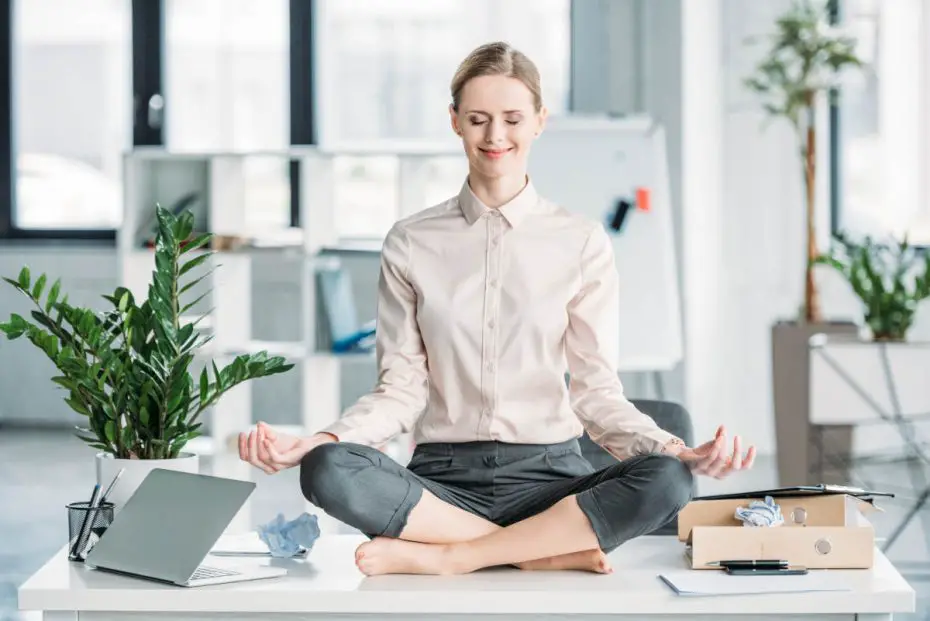In today’s fast-paced world, finding time for meditation can feel like an elusive dream amidst the demands of work, family, and other obligations. Yet, paradoxically, it is precisely during these busy moments that the need for inner peace and mindfulness is most acute.
In this article, we’ll explore practical strategies for integrating meditation into even the busiest of schedules, allowing you to cultivate a sense of calm, clarity, and presence amidst the chaos of modern life.
From creating micro-meditation moments throughout the day to prioritizing meditation as a non-negotiable self-care essential, we’ll delve into actionable tips and insights for making mindfulness a seamless part of your daily routine. By maximizing efficiency in short meditation sessions, overcoming resistance to carving out time, and integrating meditation into existing daily activities, you’ll discover how to weave the thread of mindfulness into the fabric of your life.
Whether you’re a seasoned meditator looking to deepen your practice or a beginner seeking to establish a consistent routine, this article offers valuable guidance for embracing meditation amid modern life. Join us on this journey towards greater inner peace, presence, and well-being. Let’s dive in!
Creating micro-meditation moments throughout the day
Feeling like there just aren’t enough hours in the day for meditation? You’re not alone! But what if we told you that you can reap the benefits of mindfulness without carving out huge chunks of time? Enter the world of micro-meditation: bite-sized practices you can sprinkle throughout your day for a big impact on your stress, focus, and well-being.
Think of micro-meditation as mini mental breaks, each lasting just a few minutes. These short bursts of awareness can be as simple as taking a few deep breaths, focusing on your physical sensations, or repeating a calming mantra. The beauty lies in their flexibility: you can do them anywhere, anytime, with no special equipment needed.
Why micro-meditation matters:
- Accessibility: Fits seamlessly into busy schedules, no need for dedicated meditation sessions.
- Stress reduction: Quick bursts of mindfulness can help calm the mind and ease tension.
- Improved focus: A few mindful moments can sharpen your concentration and boost productivity.
- Enhanced well-being: Regular micro-meditation practices can contribute to overall happiness and emotional balance.

Ready to give it a try? Here are some micro-meditation ideas to get you started:
- The Power of the Pause: Waiting in line? Stuck in traffic? Instead of reaching for your phone, take a few deep breaths. Close your eyes, feel the rise and fall of your chest, and simply be present in the moment. Even 30 seconds can make a difference.
- Mindful Movement: Turn your mundane tasks into mini-meditations. As you brush your teeth, focus on the sensation of the bristles against your gums. Feel your feet connect with the ground as you walk. Bring awareness to the simple act of folding laundry or washing dishes.
- Desk zen: Take a minute between tasks to sit tall, close your eyes, and scan your body for any tension. Release it with a slow exhale.
- Mealtime mindfulness: Before digging in, take a few moments to appreciate the colors, aromas, and textures of your food. Savor each bite slowly and mindfully.
- Nature break: Step outside, close your eyes, and listen to the sounds around you. Feel the sun on your skin or the wind in your hair. Simply be present in the moment.
- Gratitude Glow: Before bed, take a moment to reflect on three things you’re grateful for that day. It could be a kind word from a friend, a delicious meal, or simply the warmth of your bed. Shifting your focus to gratitude fosters positivity and promotes better sleep.
Remember, micro-meditation is all about finding what works for you. Experiment with different practices and see what resonates. The key is to be consistent, even if it’s just for a few minutes each day. You’ll be surprised at the positive impact these mini moments can have on your busy life.
| Situation | Micro-Meditation Practice | Focus |
|---|---|---|
| Waiting in line | Close your eyes and take 5 deep breaths, focusing on the rise and fall of your chest. | Grounding, calming |
| Stuck in traffic | Mindfully observe the sights and sounds around you without judgment. Notice the details of buildings, passing cars, or trees. | Present moment awareness, reducing frustration |
| Doing chores | Focus on the physical sensations of the activity. Feel the water on your hands while washing dishes, or notice the rhythm of your movements while folding laundry. | Mindfulness of body, reducing autopilot mode |
| Short phone break | Put your phone away for 2 minutes and do a short guided meditation on your phone app. Focus on relaxation or stress reduction. | Quick stress relief, refocusing |
| Before an important meeting | Take 3 deep breaths and visualize yourself feeling calm, confident, and prepared. | Boosting confidence, reducing performance anxiety |
| Feeling overwhelmed | Do a quick “body scan” meditation, focusing on different body parts and releasing tension with each exhale. | Relaxation, reducing tension and overwhelm |
Related reading: Addressing 10 Common Myths about Meditation – Opens in new tab
Maximizing efficiency in short meditation sessions
Busy schedules often leave us yearning for extended meditation sessions, but the reality is, even micro-practices can pack a powerful punch. The key lies in maximizing efficiency within those precious minutes. Here’s how to turn fleeting moments into mindfulness marvels:
- Target Your Needs: Identify what you want to achieve in your brief meditation. Feeling scattered? Focus on grounding breaths. Need a quick energy boost? Visualize invigorating sunlight. Craving emotional balance? Practice loving-kindness meditation. Tailoring your practice to your immediate need enhances its impact.
- Embrace Guided Meditations: Apps and online resources offer a treasure trove of guided meditations specifically designed for short bursts. Let an expert’s voice guide you through visualizations, breathwork, or affirmations, maximizing your focus and reaping the benefits of pre-structured practices.
- Utilize Technology: Take advantage of technology to create micro-meditation reminders. Set short timers throughout your day, use meditation apps with notification chimes, or even opt for wearable devices that buzz gently to prompt mindful moments.
- Stack Your Habits: Pair meditation with other established routines. Meditate before your morning coffee, after your workout, or while waiting for the kettle to boil. Stacking meditation onto existing habits makes it easier to integrate into your daily flow.
- Remember, progress, not perfection, is the goal. Don’t get discouraged if your mind wanders during your short sessions. Simply acknowledge the distraction and gently guide your attention back to the present moment. Each time you do, you strengthen your mindfulness muscle, making it easier to focus in the future.
Make Meditation Your Non-Negotiable
We all know self-care is crucial, but amidst to-do lists and overflowing inboxes, it’s easy to push essential practices like meditation aside. But here’s the truth: prioritizing meditation isn’t just self-care, it’s the foundation for a thriving life.
Think of it like this: you wouldn’t expect a marathon runner to skip training, would you? Meditation strengthens your mental muscles, equipping you to navigate life’s challenges with grace and resilience. It’s not a luxury, it’s your training ground for inner peace and clarity.
But how do you make meditation a non-negotiable part of your self-care routine? Here’s the key:
- Shift Your Mindset: Ditch the “shoulds” and “oughts” and reframe meditation as an investment in your well-being. See it as the gift you give yourself to be more present, focused, and emotionally balanced.
- Start Small and Be Flexible: Don’t feel pressured to meditate for an hour a day. Begin with five minutes, even two! Find a time that works for you, whether it’s first thing in the morning or before bed. Remember, consistency trumps duration.
- Make it Easy and Accessible: Download a meditation app, join a guided meditation online, or simply sit quietly with your breath. No fancy equipment required, just presence and intention.
- Become Your Own Advocate: Don’t let excuses win. If someone asks why you need “me time” for meditation, confidently explain its benefits for your mental and emotional well-being. Remember, setting boundaries is self-care too!
- Track Your Progress: Notice how meditation impacts your stress levels, focus, and overall mood. Journaling or using a mood tracker can help you see the positive changes and stay motivated.
- Find Your Meditation Community: Connect with others who prioritize mindfulness through online forums, local meditation groups, or even a buddy system with a friend. Sharing your journey can deepen your commitment and make it more enjoyable.

Related reading: Dealing With a Wandering Mind During Meditation – Opens in new tab
Overcoming resistance to carving out time
We all know the benefits of meditation, but sometimes, carving out even a few minutes feels like an uphill battle. Resistance creeps in, whispering excuses and amplifying our busy schedules. However, overcoming resistance to carving out time for meditation is essential if we want to reap the profound benefits of mindfulness.
One common barrier to establishing a regular meditation practice is the belief that we don’t have enough time. We may convince ourselves that we’re too busy, too tired, or too overwhelmed to dedicate even a few minutes to meditation. However, it’s crucial to recognize that these are often just excuses rooted in fear or discomfort.
To overcome resistance, start by examining your underlying beliefs and attitudes towards meditation. Are there any misconceptions or limiting beliefs holding you back? Challenge these beliefs with curiosity and compassion, recognizing that meditation is a gift you give yourself—not a chore to be checked off your list.
Next, reframe your relationship with time. Instead of viewing meditation as a time-consuming obligation, see it as an investment in your well-being that pays dividends throughout your day. By carving out just a few minutes each day for meditation, you create a ripple effect of calm, clarity, and resilience that can positively impact every aspect of your life.
It can also be helpful to experiment with different scheduling strategies to find what works best for you. Whether it’s meditating first thing in the morning, during your lunch break, or before bed, identify pockets of time in your day where you can prioritize self-care and mindfulness.
Additionally, enlist support from those around you. Share your commitment to meditation with friends, family, or coworkers who can help hold you accountable and provide encouragement along the way. You may even consider joining a meditation group or class to cultivate a sense of community and camaraderie in your practice.
| Resistance Reason | Solution Strategy |
|---|---|
| Lack of time: | Start with micro-meditations as short as 2 minutes. Integrate them into existing routines (e.g., waiting in line, commuting). Use meditation apps with short guided sessions. |
| Feeling self-conscious: | Remind yourself that meditation is self-practice, not a performance. Start in the privacy of your own home. Focus on internal sensations rather than external worries. |
| Finding it boring: | Explore different meditation techniques (e.g., guided meditations, walking meditation, mindfulness of breath). Use meditation apps with various options. Find practices that resonate with your interests and needs. |
| Mind keeps wandering: | This is normal! Gently redirect your attention to your breath or another anchor. Don’t judge yourself for distractions, simply acknowledge and move on. |
| Not seeing results: | Be patient and kind to yourself. Meditation is a skill that develops over time. Focus on the process, not the outcome. Celebrate small progress and enjoy the journey. |
Related reading: Freeing Your Mind: 5 Cultural and Religious Misconceptions about Meditation – Opens in new tab
Conclusion: Your Journey to Inner Peace Starts Now
Remember, meditation isn’t about achieving some unattainable state of perfection. It’s about cultivating a deeper connection with yourself, fostering inner peace, and navigating life’s challenges with greater clarity and resilience. Every mindful breath, every moment of focused awareness, is a step towards a more balanced and fulfilling life.
So, don’t wait for the perfect moment to start. Begin with a micro-moment today. Take a few deep breaths, savor your morning coffee with awareness, or turn your commute into a mini-meditation. As you integrate these practices into your routine, you’ll discover that inner peace isn’t a destination, it’s a journey. And the most beautiful part? You’re already on it.
Embrace the exploration, celebrate your progress, and remember, your well-being is worth the investment. May your journey to inner peace be filled with moments of mindfulness, clarity, and the profound joy of simply being present.
As a reminder of the benefits of meditation, I am including the table below that summarizes the scientific research on the benefits of regular meditation practice.
| Benefit | Description |
| Reduced Stress | Regular meditation practice has been shown to lower cortisol levels, reducing overall stress.1 |
| Improved Focus | Meditation strengthens attention and concentration, leading to improved focus and productivity. 2 |
| Emotional Regulation | By fostering awareness of emotions, meditation helps regulate mood and reduce reactivity.3 |
| Enhanced Sleep | Mindfulness meditation can improve sleep quality by promoting relaxation and reducing insomnia.4 |
| Increased Well-being | Research suggests that regular meditation practice is associated with greater overall well-being.5 |
Do you want to learn more about Meditation? Check out our recommendations at “Meditation Bookshelf” and many free resources at our “Free MeditationLibrary“ – Opens in new tab
- Jevning R, Wilson AF, Davidson JM. Adrenocortical activity during meditation. Horm Behav. 1978 Feb;10(1):54-60. doi: 10.1016/0018-506x(78)90024-7. PMID: 350747. ↩︎
- Tang YY, Ma Y, Fan Y, Feng H, Wang J, Feng S, Lu Q, Hu B, Lin Y, Li J, Zhang Y, Wang Y, Zhou L, Fan M. Central and autonomic nervous system interaction is altered by short-term meditation. Proc Natl Acad Sci U S A. 2009 Jun 2;106(22):8865-70. doi: 10.1073/pnas.0904031106. Epub 2009 May 18. PMID: 19451642; PMCID: PMC2690030. ↩︎
- Hölzel BK, Carmody J, Vangel M, Congleton C, Yerramsetti SM, Gard T, Lazar SW. Mindfulness practice leads to increases in regional brain gray matter density. Psychiatry Res. 2011 Jan 30;191(1):36-43. doi: 10.1016/j.pscychresns.2010.08.006. Epub 2010 Nov 10. PMID: 21071182; PMCID: PMC3004979. ↩︎
- Black DS, O’Reilly GA, Olmstead R, Breen EC, Irwin MR. Mindfulness meditation and improvement in sleep quality and daytime impairment among older adults with sleep disturbances: a randomized clinical trial. JAMA Intern Med. 2015 Apr;175(4):494-501. doi: 10.1001/jamainternmed.2014.8081. PMID: 25686304; PMCID: PMC4407465. ↩︎
- Diener, E., Wirtz, D., Tov, W., Kim-Prieto, C., Choi, D., Oishi, S., & Biswas-Diener, R. (2009). New measures of well-being: Flourishing and positive and negative feelings. Social Indicators Research, 39(2), 247-266. ↩︎
Stay in Touch
 Join our newsletter by using the forms on this website or click here!
Join our newsletter by using the forms on this website or click here! Follow us on Google News
Follow us on Google News Follow us on Facebook
Follow us on Facebook
Featured image from Depositphotos






